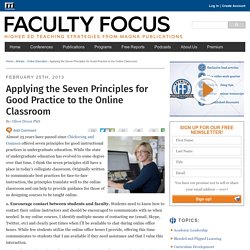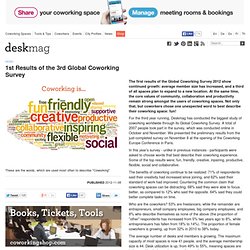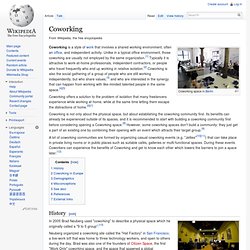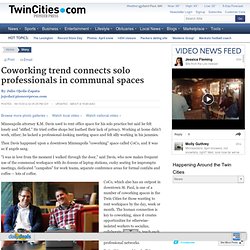

Applying the Seven Principles for Good Practice to the Online Classroom. Almost 25 years have passed since Chickering and Gamson offered seven principles for good instructional practices in undergraduate education.

While the state of undergraduate education has evolved to some degree over that time, I think the seven principles still have a place in today’s collegiate classroom. Originally written to communicate best practices for face-to-face instruction, the principles translate well to the online classroom and can help to provide guidance for those of us designing courses to be taught online. 1. Encourage contact between students and faculty. Students need to know how to contact their online instructors and should be encouraged to communicate with us when needed. 2. 3. 4. 5. 6. 7.
Coworking Explained & How To Make It Work for You. Posted on 26'13 Feb Posted on February 26, 2013 along with 23 JUST™ Creative Comments.

Unconference. Open space session scheduling History[edit] Unconferences often use variations on the Open Space Technology format / method developed by Harrison Owen in the mid 1980s.

Owen's 1993 book Open Space Technology: a User's Guide discussed many of the techniques now associated with unconferences, although his book does not use that term. The term "unconference" first appeared in an announcement for the annual XML developers conference in 1998.[2] The term was used by Lenn Pryor when discussing BloggerCon and was popularized by Dave Winer, the organizer of BloggerCon, in an April 2004 writeup.
Personal learning network. A personal learning network is an informal learning network that consists of the people a learner interacts with and derives knowledge from in a personal learning environment. In a PLN, a person makes a connection with another person with the specific intent that some type of learning will occur because of that connection.[1][2] The following is an excerpt from Dryden's and Vos' book on learning networks:[4] "For the first time in history, we know now how to store virtually all humanity's most important information and make it available, almost instantly, in almost any form, to almost anyone on earth. We also know how to do that in great new ways so that people can interact with it , and learn from it. " 1st Results of the 3rd Global Coworking Survey.
The first results of the Global Coworking Survey 2012 show continued growth: average member size has increased, and a third of all spaces plan to expand to a new location.

At the same time, the core values of community, collaboration and productivity remain strong amongst the users of coworking spaces. Not only that, but coworkers chose one unexpected word to best describe their coworking space: fun! For the third year running, Deskmag has conducted the biggest study of coworking worldwide through its Global Coworking Survey.
A total of 2007 people took part in the survey, which was conducted online in October and November. We presented the preliminary results from the just-completed survey on November 8 at the opening of the Coworking Europe Conference in Paris. How In-Person Meetups Are Fixing The Problem With MOOCs. By Paul Glader, Managing Editor of WiredAcademic BERLIN – Somewhere between the cookie cutter Prussian-style classroom model of education and the lone-ranger online learning idea lurks the blended learning ideal, where one can have concentrated individualized learning time balanced with work among a small community of like-minded learners. Plato and others had this figured out thousands of years ago. It’s coming back. A few weeks ago, I signed up for a Coursera class – a massive open online course, or MOOC – a month ago and signed on to watch my first lecture this past week.
Then, I dropped out (or, more politely, “unenrolled.”) Why? It wasn’t the teacher’s fault, Coursera’s fault or the fault of the course content. See Also: 5 Potential Ways MOOCs Will Evolve I’m signed up for another Coursera class in the spring that I think will be more directly useful to projects I have underway. Coworking. Coworking is a style of work that involves a shared working environment, often an office, and independent activity.

Unlike in a typical office environment, those coworking are usually not employed by the same organization.[1] Typically it is attractive to work-at-home professionals, independent contractors, or people who travel frequently who end up working in relative isolation.[2] Coworking is also the social gathering of a group of people who are still working independently, but who share values,[3] and who are interested in the synergy that can happen from working with like-minded talented people in the same space.[4][5] Coworking offers a solution to the problem of isolation that many freelancers experience while working at home, while at the same time letting them escape the distractions of home.[6][7] Coworking is not only about the physical space, but about establishing the coworking community first.
GeekEasy Co-Working Space in Washington, DC. My Top 6 Trends in the Coworking Industry. Anyone would jump at the chance to learn something new and meet unique, smart industry people in a cool out-of-town spot.

When I discovered the Austin Global Coworking Unconference Conference (GCUC, pronounced “juicy”), I knew this would be one of those moments. And it was more than I could have imagined. First of all, going to Austin, TX in any vicinity of SXSW is going to be 1) the perfect time to run into "startup celebrities", 2) an educational opportunity to share best practices, and 3) a heck of a good time! But even though the majority of my Austin experience was beyond amazing, my trip had a rocky start. It all began with another crazy Kansas City snow storm which delayed my arrival to the conference by two hours. The unconference/conference was packed with coworking space managers, owners and aspiring founders. Coworking trend connects solo professionals in communal spaces.
Minneapolis attorney K.M.

Davis used to rent office space for his solo practice but said he felt lonely and "stifled. " He tried coffee shops but loathed their lack of privacy. Working at home didn't work, either; he lacked a professional-looking meeting space and felt silly working in his jammies. Worried about your future? Why Joining a Co Working Site is a Good Idea.